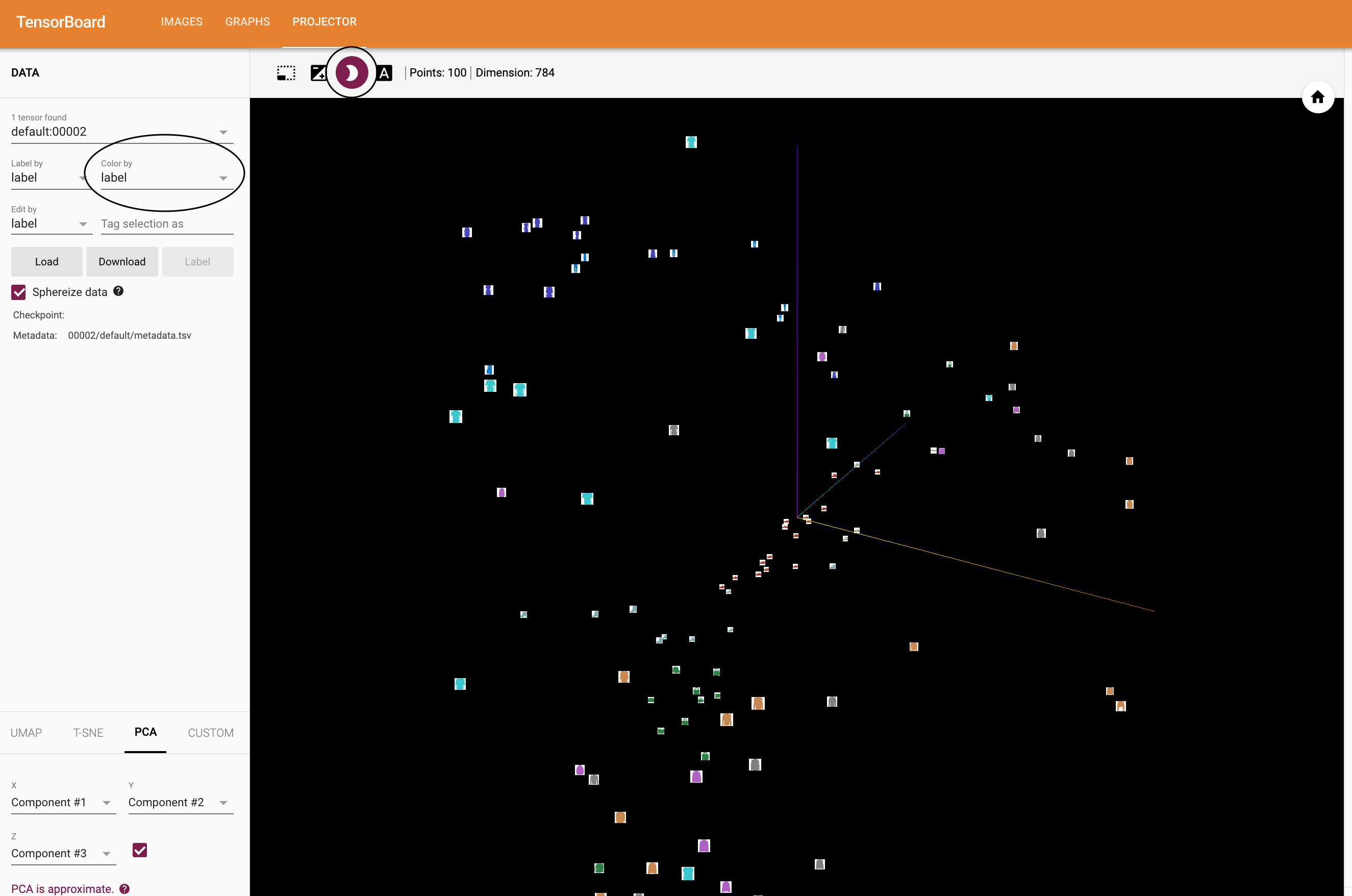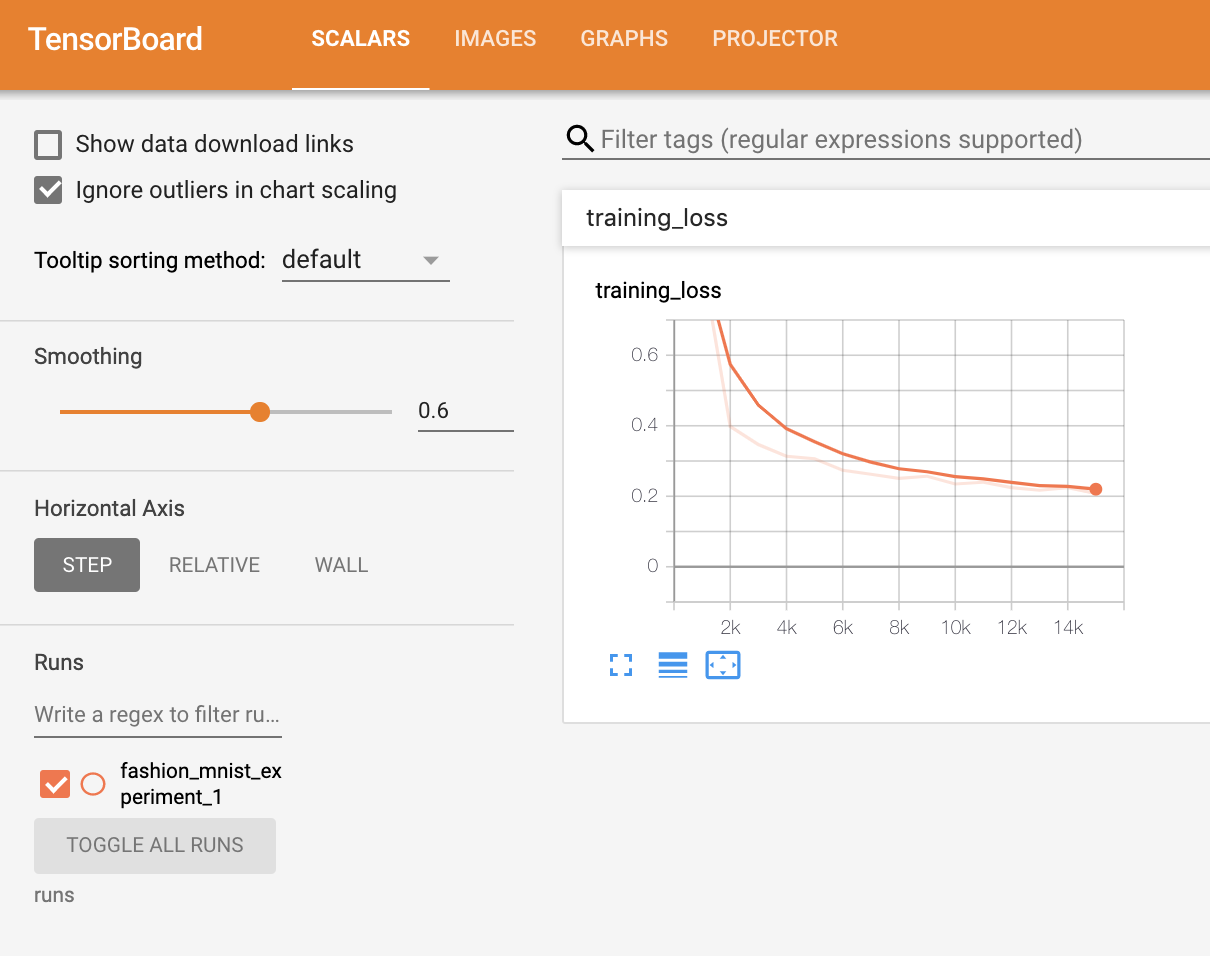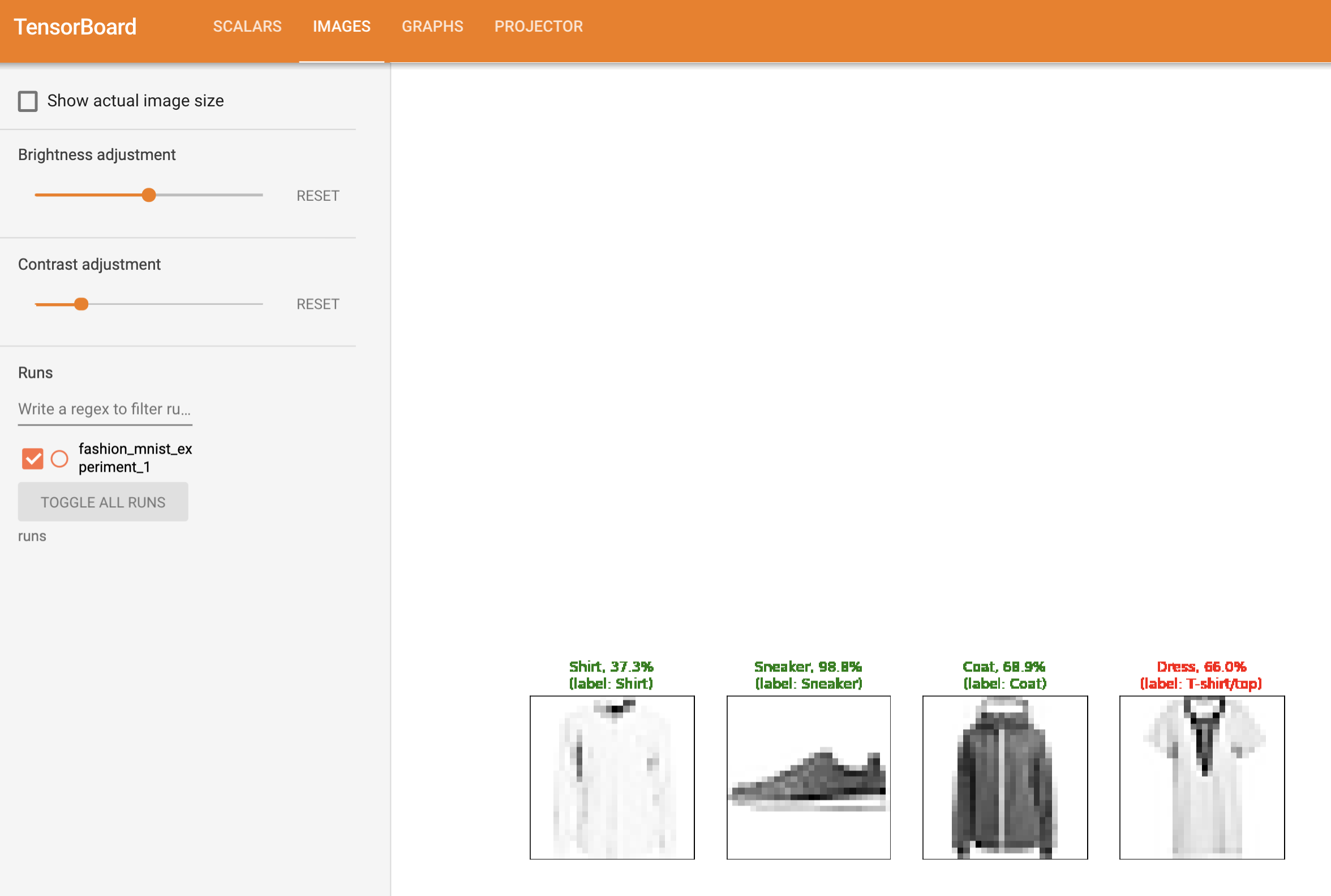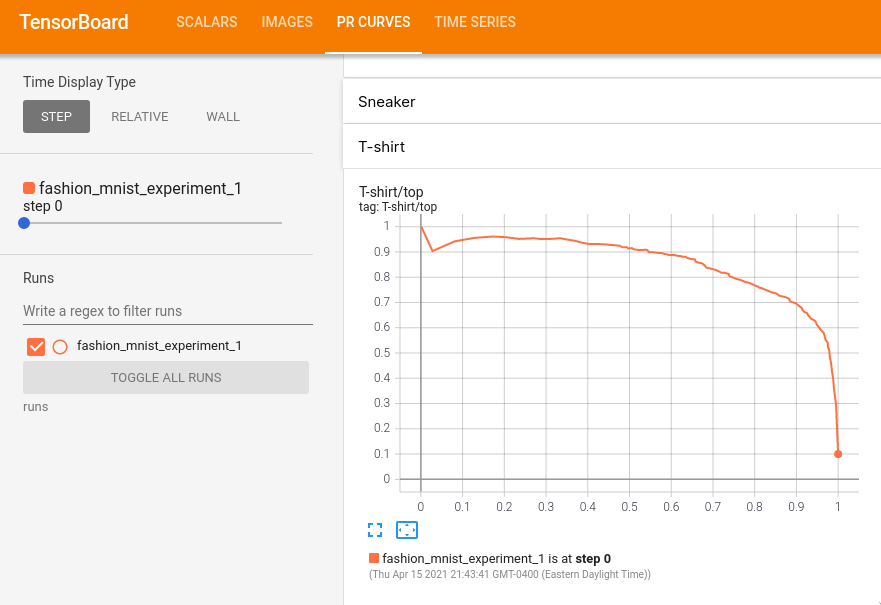使用 TensorBoard 可视化模型、数据和训练
创建于:2025 年 4 月 1 日 | 最后更新:2025 年 4 月 1 日 | 最后验证:2024 年 11 月 5 日
在 60 分钟闪电战中,我们向您展示如何加载数据,将其通过我们定义的作为 nn.Module 子类的模型进行传递,在训练数据上训练此模型,并在测试数据上对其进行测试。为了了解正在发生的事情,我们在模型训练时打印出一些统计数据,以了解训练是否在进展。然而,我们可以做得更好:PyTorch 与 TensorBoard 集成,这是一个用于可视化神经网络训练运行结果的工具。本教程展示了其一些功能,使用 Fashion-MNIST 数据集,该数据集可以使用 torchvision.datasets 读取到 PyTorch 中。
在本教程中,我们将学习如何:
读取数据并使用适当的转换(几乎与之前的教程相同)。
设置 TensorBoard。
向 TensorBoard 写入。
使用 TensorBoard 检查模型架构。
使用 TensorBoard 创建我们在上一个教程中创建的可视化的交互式版本,代码更少
具体来说,在第 5 点,我们将看到:
检查我们的训练数据的一些方法
如何跟踪我们的模型在训练过程中的性能
如何评估训练好的模型性能。
我们将从与 CIFAR-10 教程中类似的样板代码开始:
# imports
import matplotlib.pyplot as plt
import numpy as np
import torch
import torchvision
import torchvision.transforms as transforms
import torch.nn as nn
import torch.nn.functional as F
import torch.optim as optim
# transforms
transform = transforms.Compose(
[transforms.ToTensor(),
transforms.Normalize((0.5,), (0.5,))])
# datasets
trainset = torchvision.datasets.FashionMNIST('./data',
download=True,
train=True,
transform=transform)
testset = torchvision.datasets.FashionMNIST('./data',
download=True,
train=False,
transform=transform)
# dataloaders
trainloader = torch.utils.data.DataLoader(trainset, batch_size=4,
shuffle=True, num_workers=2)
testloader = torch.utils.data.DataLoader(testset, batch_size=4,
shuffle=False, num_workers=2)
# constant for classes
classes = ('T-shirt/top', 'Trouser', 'Pullover', 'Dress', 'Coat',
'Sandal', 'Shirt', 'Sneaker', 'Bag', 'Ankle Boot')
# helper function to show an image
# (used in the `plot_classes_preds` function below)
def matplotlib_imshow(img, one_channel=False):
if one_channel:
img = img.mean(dim=0)
img = img / 2 + 0.5 # unnormalize
npimg = img.numpy()
if one_channel:
plt.imshow(npimg, cmap="Greys")
else:
plt.imshow(np.transpose(npimg, (1, 2, 0)))
我们将定义与该教程中类似的模型架构,仅进行少量修改以适应图像现在是一通道而不是三通道,以及 28x28 而不是 32x32:
class Net(nn.Module):
def __init__(self):
super(Net, self).__init__()
self.conv1 = nn.Conv2d(1, 6, 5)
self.pool = nn.MaxPool2d(2, 2)
self.conv2 = nn.Conv2d(6, 16, 5)
self.fc1 = nn.Linear(16 * 4 * 4, 120)
self.fc2 = nn.Linear(120, 84)
self.fc3 = nn.Linear(84, 10)
def forward(self, x):
x = self.pool(F.relu(self.conv1(x)))
x = self.pool(F.relu(self.conv2(x)))
x = x.view(-1, 16 * 4 * 4)
x = F.relu(self.fc1(x))
x = F.relu(self.fc2(x))
x = self.fc3(x)
return x
net = Net()
我们将定义与之前相同的 optimizer 和 criterion :
criterion = nn.CrossEntropyLoss()
optimizer = optim.SGD(net.parameters(), lr=0.001, momentum=0.9)
1. TensorBoard 配置 ¶
现在我们将设置 TensorBoard,导入 tensorboard 从 torch.utils ,并定义一个 SummaryWriter ,这是我们写入 TensorBoard 信息的关键对象。
from torch.utils.tensorboard import SummaryWriter
# default `log_dir` is "runs" - we'll be more specific here
writer = SummaryWriter('runs/fashion_mnist_experiment_1')
注意,仅此一行就创建了一个 runs/fashion_mnist_experiment_1 文件夹。
2. 写入 TensorBoard ¶
现在我们将使用 make_grid 将一张图片写入我们的 TensorBoard - 具体来说,是一个网格。
# get some random training images
dataiter = iter(trainloader)
images, labels = next(dataiter)
# create grid of images
img_grid = torchvision.utils.make_grid(images)
# show images
matplotlib_imshow(img_grid, one_channel=True)
# write to tensorboard
writer.add_image('four_fashion_mnist_images', img_grid)
现在正在运行
tensorboard --logdir=runs
从命令行运行并导航到 http://localhost:6006 应该会显示以下内容。

现在您已经知道如何使用 TensorBoard 了!然而,这个例子也可以在 Jupyter Notebook 中完成——TensorBoard 真正擅长的是创建交互式可视化。我们将在下一个教程中介绍其中之一,并在教程结束时介绍更多。
使用 TensorBoard 检查模型 ¶
TensorBoard 的优势之一是其可视化复杂模型结构的能力。让我们可视化我们构建的模型。
writer.add_graph(net, images)
writer.close()
现在刷新 TensorBoard 后,你应该会看到一个类似这样的“图形”标签页:

双击“Net”以查看其展开,看到构成模型的各个操作的详细视图。
TensorBoard 具有一个非常实用的功能,可以将高维数据(如图像数据)可视化到低维空间中;我们将在下一节介绍这个功能。
4. 将“Projector”添加到 TensorBoard ¶
我们可以通过 add_embedding 方法可视化高维数据的低维表示。
# helper function
def select_n_random(data, labels, n=100):
'''
Selects n random datapoints and their corresponding labels from a dataset
'''
assert len(data) == len(labels)
perm = torch.randperm(len(data))
return data[perm][:n], labels[perm][:n]
# select random images and their target indices
images, labels = select_n_random(trainset.data, trainset.targets)
# get the class labels for each image
class_labels = [classes[lab] for lab in labels]
# log embeddings
features = images.view(-1, 28 * 28)
writer.add_embedding(features,
metadata=class_labels,
label_img=images.unsqueeze(1))
writer.close()
现在,在 TensorBoard 的“投影仪”标签页中,您可以看到这 100 张图像——每张图像都是 784 维的——被投影到三维空间中。此外,这是交互式的:您可以点击并拖动来旋转三维投影。最后,提供一些建议以使可视化更容易看到:在左上角选择“颜色:标签”,以及启用“夜间模式”,这将使图像更容易看到,因为它们的背景是白色的:

现在我们已经彻底检查了我们的数据,让我们看看 TensorBoard 如何使模型训练和评估的跟踪更清晰,从训练开始。
5. 使用 TensorBoard 跟踪模型训练
在上一个例子中,我们只是每 2000 次迭代打印一次模型的运行损失。现在,我们将运行损失记录到 TensorBoard 中,并通过 plot_classes_preds 函数查看模型所做的预测。
# helper functions
def images_to_probs(net, images):
'''
Generates predictions and corresponding probabilities from a trained
network and a list of images
'''
output = net(images)
# convert output probabilities to predicted class
_, preds_tensor = torch.max(output, 1)
preds = np.squeeze(preds_tensor.numpy())
return preds, [F.softmax(el, dim=0)[i].item() for i, el in zip(preds, output)]
def plot_classes_preds(net, images, labels):
'''
Generates matplotlib Figure using a trained network, along with images
and labels from a batch, that shows the network's top prediction along
with its probability, alongside the actual label, coloring this
information based on whether the prediction was correct or not.
Uses the "images_to_probs" function.
'''
preds, probs = images_to_probs(net, images)
# plot the images in the batch, along with predicted and true labels
fig = plt.figure(figsize=(12, 48))
for idx in np.arange(4):
ax = fig.add_subplot(1, 4, idx+1, xticks=[], yticks=[])
matplotlib_imshow(images[idx], one_channel=True)
ax.set_title("{0}, {1:.1f}%\n(label: {2})".format(
classes[preds[idx]],
probs[idx] * 100.0,
classes[labels[idx]]),
color=("green" if preds[idx]==labels[idx].item() else "red"))
return fig
最后,让我们使用之前教程中的相同模型训练代码来训练模型,但将结果写入 TensorBoard,而不是打印到控制台;这是通过 add_scalar 函数完成的,每 1000 个批次写入一次。
此外,随着我们的训练,我们还将生成一个图像,展示模型在那一批次的四张图像上的预测结果与实际结果。
running_loss = 0.0
for epoch in range(1): # loop over the dataset multiple times
for i, data in enumerate(trainloader, 0):
# get the inputs; data is a list of [inputs, labels]
inputs, labels = data
# zero the parameter gradients
optimizer.zero_grad()
# forward + backward + optimize
outputs = net(inputs)
loss = criterion(outputs, labels)
loss.backward()
optimizer.step()
running_loss += loss.item()
if i % 1000 == 999: # every 1000 mini-batches...
# ...log the running loss
writer.add_scalar('training loss',
running_loss / 1000,
epoch * len(trainloader) + i)
# ...log a Matplotlib Figure showing the model's predictions on a
# random mini-batch
writer.add_figure('predictions vs. actuals',
plot_classes_preds(net, inputs, labels),
global_step=epoch * len(trainloader) + i)
running_loss = 0.0
print('Finished Training')
现在,您可以通过查看标量标签来查看训练过程中的运行损失在 15,000 次迭代中的变化:

此外,我们还可以查看模型在整个学习过程中对任意批次所做的预测。请查看“图像”标签,并在“预测与实际”可视化部分向下滚动,以查看这一点;这表明,例如,在仅仅 3000 次训练迭代后,模型已经能够区分视觉上不同的类别,如衬衫、运动鞋和外套,尽管它不像训练后期那样自信:

在之前的教程中,我们查看了一次模型训练完成后的每类准确率;在这里,我们将使用 TensorBoard 为每个类别绘制精度-召回曲线(这里有一个很好的解释)。
6. 使用 TensorBoard 评估训练模型 ¶
# 1. gets the probability predictions in a test_size x num_classes Tensor
# 2. gets the preds in a test_size Tensor
# takes ~10 seconds to run
class_probs = []
class_label = []
with torch.no_grad():
for data in testloader:
images, labels = data
output = net(images)
class_probs_batch = [F.softmax(el, dim=0) for el in output]
class_probs.append(class_probs_batch)
class_label.append(labels)
test_probs = torch.cat([torch.stack(batch) for batch in class_probs])
test_label = torch.cat(class_label)
# helper function
def add_pr_curve_tensorboard(class_index, test_probs, test_label, global_step=0):
'''
Takes in a "class_index" from 0 to 9 and plots the corresponding
precision-recall curve
'''
tensorboard_truth = test_label == class_index
tensorboard_probs = test_probs[:, class_index]
writer.add_pr_curve(classes[class_index],
tensorboard_truth,
tensorboard_probs,
global_step=global_step)
writer.close()
# plot all the pr curves
for i in range(len(classes)):
add_pr_curve_tensorboard(i, test_probs, test_label)
您现在将看到一个“PR 曲线”标签页,其中包含每个类别的精度-召回曲线。您可以随意探索;您会发现,在某些类别上,模型的“曲线下面积”接近 100%,而在其他类别上这个面积较低:

这就是 TensorBoard 和 PyTorch 与其集成的简介。当然,您可以在 Jupyter Notebook 中完成 TensorBoard 的所有操作,但使用 TensorBoard,您默认获得交互式的视觉效果。